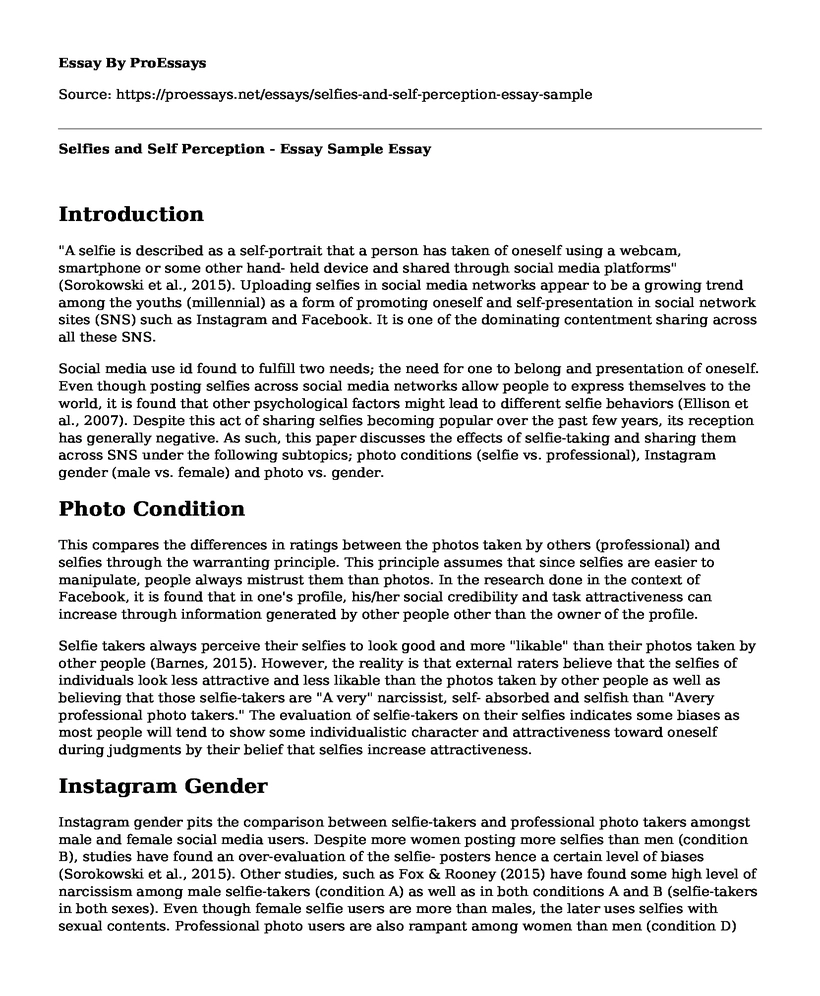Introduction
"A selfie is described as a self-portrait that a person has taken of oneself using a webcam, smartphone or some other hand- held device and shared through social media platforms" (Sorokowski et al., 2015). Uploading selfies in social media networks appear to be a growing trend among the youths (millennial) as a form of promoting oneself and self-presentation in social network sites (SNS) such as Instagram and Facebook. It is one of the dominating contentment sharing across all these SNS.
Social media use id found to fulfill two needs; the need for one to belong and presentation of oneself. Even though posting selfies across social media networks allow people to express themselves to the world, it is found that other psychological factors might lead to different selfie behaviors (Ellison et al., 2007). Despite this act of sharing selfies becoming popular over the past few years, its reception has generally negative. As such, this paper discusses the effects of selfie-taking and sharing them across SNS under the following subtopics; photo conditions (selfie vs. professional), Instagram gender (male vs. female) and photo vs. gender.
Photo Condition
This compares the differences in ratings between the photos taken by others (professional) and selfies through the warranting principle. This principle assumes that since selfies are easier to manipulate, people always mistrust them than photos. In the research done in the context of Facebook, it is found that in one's profile, his/her social credibility and task attractiveness can increase through information generated by other people other than the owner of the profile.
Selfie takers always perceive their selfies to look good and more "likable" than their photos taken by other people (Barnes, 2015). However, the reality is that external raters believe that the selfies of individuals look less attractive and less likable than the photos taken by other people as well as believing that those selfie-takers are "A very" narcissist, self- absorbed and selfish than "Avery professional photo takers." The evaluation of selfie-takers on their selfies indicates some biases as most people will tend to show some individualistic character and attractiveness toward oneself during judgments by their belief that selfies increase attractiveness.
Instagram Gender
Instagram gender pits the comparison between selfie-takers and professional photo takers amongst male and female social media users. Despite more women posting more selfies than men (condition B), studies have found an over-evaluation of the selfie- posters hence a certain level of biases (Sorokowski et al., 2015). Other studies, such as Fox & Rooney (2015) have found some high level of narcissism among male selfie-takers (condition A) as well as in both conditions A and B (selfie-takers in both sexes). Even though female selfie users are more than males, the later uses selfies with sexual contents. Professional photo users are also rampant among women than men (condition D) which further strengthens the reason as to why women are the most users of Instagram in terms of image shared.
Photo vs. Gender
The practice of using selfies and photos in social media platforms to promote one's self- definition, relational interaction and identity construction are rampant among adolescent youths. They use pictures to garner approval from their peers to feel self-promoted. However, this act is common among female users (both conditions B and D) than in male users. The teenagers are however cautious when they are taking photos and selfies as they focus on the content to show others on the internet as most of them fear their images getting into wrong hands who could end up using them for "evil purposes "especially females images. Sexual aspects of selfies are rampant among girls since they are concerned with self-attractiveness and approval (Condition A) while boys only see social media selfies and photos as a form of self-promotion. (Kim and Chock, 2015).
Even though self and photo usage across social media networks is gaining momentum in the current world today, there are privacy issues which come with its usage which seem to affect young adults more than adolescent adults and women more than men. However, photo sharing across social networks appears to be inversely related to privacy as even the privacy issues do not seem to limit the content shared in Social Media Networks.
References
Barnes, S. (2015). Like, Follow, Share: Awesome, Actionable Social Media Marketing to Maximize Your Online Potential. Callisto Media Inc.
Ellison, N. B., Steinfield, C., & Lampe, C. (2007). The benefits of Facebook "friends:" Social capital and college students' use of online social network sites. Journal of computer-mediated communication, 12(4), 1143-1168.
Fox, J., & Rooney, M. C. (2015). The Dark Triad and trait self-objectification as predictors of men's use and self-presentation behaviors on social networking sites. Personality and Individual Differences, 76, 161-165.
Kim, J. W., & Chock, T. M. (2015). Body image 2.0: Associations between social grooming on Facebook and body image concerns. Computers in human behavior, 48, 331-339.
Sorokowski, P., Sorokowska, A., Oleszkiewicz, A., Frackowiak, T., Huk, A., & Pisanski, K. (2015). Selfie posting behaviors are associated with narcissism among men. Personality and Individual Differences, 85, 123-127.
Cite this page
Selfies and Self Perception - Essay Sample. (2022, Dec 04). Retrieved from https://proessays.net/essays/selfies-and-self-perception-essay-sample
If you are the original author of this essay and no longer wish to have it published on the ProEssays website, please click below to request its removal:
- Happy Days, Season 1, Episode 1 - All the Way. Movie Review Example.
- Early Jazz Big Swing Music
- Critical Essay on Orientalism by Edward Said
- Health Assignment on Documentary "What the Health" Essay
- The Role of The Supernatural in Literature Essay Example
- Biographical Essay on Lenore Tawney
- Movie Analysis Essay on The Life Equation







